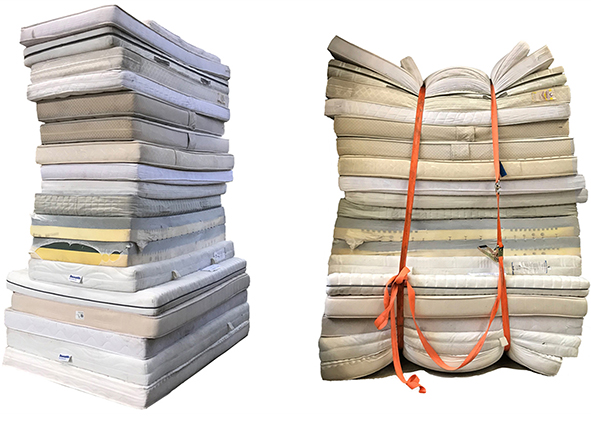Resource mattress. The potential of refuse materials
DOI:
https://doi.org/10.19229/2464-9309/9182021Keywords:
experimental architecture, material research, waste elimination, insulation, lightweightAbstract
Mattresses are multi-material products whose exact composition is mostly unknown to the waste collector, so they can hardly be recycled and continue to be incinerated. Valuable resources are lost and no longer returned to the material cycle. Foam re-use and mechanical recycling account for only a negligible share of the market. The research presented here explores the potential of re-using mattresses as thermal and acoustic insulation for construction projects and attempts to find re-purpose in order to reduce waste and emissions, save resources and provide the insulation needed. This specific case study serves as a method to identify and demonstrate the flow and potential on a much larger scale. Considering comparable and possibly compatible properties of different foams this study explores the possibility of using them in a larger format. The approach is based on an unbiased exploration of the material, which only as a second step uses scientific methods to measure the intuitive exploration of the properties.
Downloads
Article Metrics Graph
References
BASF (2020), “BASF working toward circularity in recycling of mattresses”, in BASF, 29/06/2020. [Online] Available at: basf.com/global/en/media/news-releases/2020/06/p-20-226.html [Accessed 06 April 2021].
Ellen MacArthur Foundation (2013), Towards the Circular Economy – Economic and business rationale for an accelerated transition. [Online] Available at: ellenmacarthurfoundation.org/assets/downloads/publications/Ellen-MacArthur-Foundation-Towards-the-Circular-Economy-vol.1.pdf [Accessed 06 April 2021].
European Commission (n.d.), Treatment of mattresses for improved recycling of materials. [Online] Available at: greenbestpractice.jrc.ec.europa.eu/node/139 [Accessed 15 May 2021].
EUROPUR (2015), Flexible Polyurethane (PU) Foam – Eco-profiles and Environmental Product Declarations of the European Plastics Manufacturers – August 2015. [Online] Available at: europur.org/sustainabilty/ecoprofile-of-pu-flexible-foam [Accessed 06 April 2021].
Fastabend, A. (2021), “Matratzen, setzt doch uns vor die Tür! – Alltag in Coronazeiten”, in Taz, newspaper, 22/02/2021. [Online] Available at: taz.de/Alltag-in-Coronazeiten/!5749866/ [Accessed 06 April 2021].
Fraunhofer ICT (2019), “Was passiert mit 30 Millionen Matratzen pro Jahr?”, in ict.fraunhofer.de, 09/04/2019. [Online] Available at: ict.fraunhofer.de/de/presse_mediathek/pressemitteilungen/2019/2019-04-09.html [Accessed 06 April 2021].
Heisel, F. (2020), “Reuse and Recycling – Materializing a Circular Construction”, in Ruby, I. and Ruby, A. (eds), The Material Book, Ruby Press, Berlin, pp. 156-160.
Köbberling, F. (n.d.), “Resources”, in iak-tu-bs.de. [Online] Available at: iak-tu-bs.de/forschung.html [Accessed 06 April 2021].
Meyer, F. (2008), “Wie entsteht ein Polyurethanschaum? – Grundlagen der PUR-Schaumherstellung”, in FSK Magazin | Polyurethane, pp. 4-7. [Online] Available at: pur-schaumkunststoffe.de/wp-content/uploads/2016/05/FSK_Magazin_Polyurethan_2008.pdf [Accessed 06 April 2021].
Nierhaus, I. and Heinz, K. (eds), Matratze / Matritze – Möblierung von Subjekt und Gesellschaft – Konzepte in Kunst und Architektur, trasnsript Verlag, Bielefeld. [Online] Available at: transcript-verlag.de/978-3-8376-3205-7/matratze/matrize/ [Accessed 06 April 2021].
Sutton, A. Black, D. and Walker, P. (2011), “Natural fibre insulation – An introduction to low-impact building materials”, in BRE publications, IP 18/11. [Online] Available at: bre.co.uk/filelibrary/pdf/projects/low_impact_materials/IP18_11.pdf [Accessed 22 April 2021].
Wainwright, O. (2020), “The case for ... never demolishing another building”, in The Guardian, newspaper, 13/01/2020. [Online] Available at: theguardian.com/cities/2020/jan/13/the-case-for-never-demolishing-another-building [Accessed 06 April 2021].
Umwelt Bundesamt (2017), “Urban Mining”, in umweltbundesamt.de, 08/05/2017. [Online] Available at: umweltbundesamt.de/themen/abfall-ressourcen/abfallwirtschaft/urban-mining [Accessed 06 April 2021].

Downloads
Published
How to Cite
Issue
Section
License
This Journal is published under Creative Commons Attribution Licence 4.0 (CC-BY).
License scheme | Legal code
This License allows anyone to:
Share: copy and redistribute the material in any medium or format.
Adapt: remix, transform, and build upon the material for any purpose, even commercially.
Under the following terms
Attribution: Users must give appropriate credit, provide a link to the license, and indicate if changes were made; users may do so in any reasonable manner, but not in any way that suggests the licensor endorses them or their use.
No additional restrictions: Users may not apply legal terms or technological measures that legally restrict others from doing anything the license permits.
Notices
Users do not have to comply with the license for elements of the material in the public domain or where your use is permitted by an applicable exception or limitation.
No warranties are given. The license may not give users all of the permissions necessary for their intended use. For example, other rights such as publicity, privacy, or moral rights may limit how you use the material.


















































































